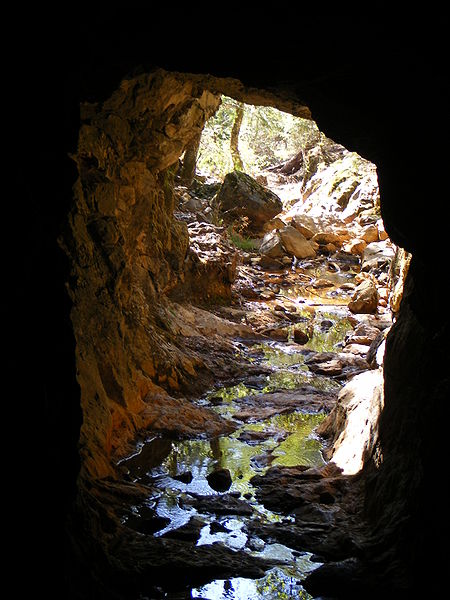Blasting a tunnel into solid rock is a process that is often encountered in mining. In performing this, the very first thing you have to remember is that any shot obeys the laws of fluid dynamics. The shot is made up so there are four large round holes at least 2 inches in diameter in the center of the shot pattern. These large holes are arranged in a diamond shape that is about 6 inches between centers, and are left empty. The four large center holes are left empty so that the shattered rock from the subsequent blast will find its way towards the center of the tunnel.
 |
| An abandoned mine tunnel Photo by J. Smith |
The remaining holes are arranged in a concentric pattern around the center.
With the use of millisecond delay caps fired electrically it is possible to cause explosions in a concentric circle with the individual shots delayed just enough so the action of the explosion by obeying the laws of fluid dynamics will cause the rock fragments to be sucked out into the tunnel away from the blast site.
In this case you can arrange the holes keeping in mind that 1 pound of modern explosives will remove approximately 1 ton of rock. A cubic foot of rock weighs approximately 2800 pounds allowing you to calculate the shot pattern based on the amount of explosives that are used. In most tunneling shots it is very rare to use holes that are larger than 1 inch in diameter, and 6 to 10 feet deep.
 |
| A tunnel inside a salt mine. Photo by Ealdgyth |
The process of removing the rock that was shattered by the shot is called “mucking” and the shattered rock is called “muck.” All the shattered rock has to be removed, or mucked before placing the next shot. It is important to make your tunnel slightly larger than its intended size by a few inches to allow for the variation in the way rock is shattered by the blast.
You can get additional information about blasting in general, or blasting in particular from your local explosives dealer. He will also have books available on the subject, or at least can tell you where to find them. Most of these books will tell you how to blast in any situation, and explain how to set the charge, what explosives to use and what type of blasting caps or other devices to initiate the charge.
As a consulting geologist while working with blasters I often had to design charges for specific types of blasting; humbling was one of them. A lot of this experience was gained through highway construction or Quarrying projects. The largest blast that we presided over was128,000 pounds of powder that was shot all at once. We literally tore out 1/2 mile of ledge with this single shot.

No comments:
Post a Comment